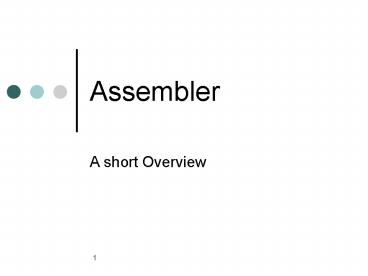Assembler - PowerPoint PPT Presentation
1 / 22
Title: Assembler
1
Assembler
- A short Overview
2
Content
- Language Levels
- High Level ? micro code
- Machinecode language
- Assembler languages
- Structure
- Commands
3
Language Levels
High Level Language
Assembler Language
Normally deepest free accessible Level
Machine Language
Micro -programming
Firmware
Hardware
4
High Level ? Micro Code
- High Level language
- Formulating program for certain application areas
- Hardware independent
- Assembler languages
- Machine oriented language
- Programs orient on special hardware properties
- More comfortable than machine code
- (e.g. by using symbolic notations)
5
High Level ? Micro Code
- Machine code
- Set of commands directly executable via CPU
- Commands in numeric code
- Lowest semantic level
- Generally 2 executing oportunities
- Interpretiv via micro code
- Directly processing via hardware
6
High Level ? Micro Code
- Micro programming
- Implementing of executing of machine commands
(Control unit - controller) - Machine command executed/shown as sequence of
micro code commands - Micro code commands
- Simpliest process controlling
- Moving of data
- Opening of grids
- Tests
7
Machinecode language
- Machinecode command
- Binary word (fix length, causes elementary
operations within CPU) - Machinecode program
- sequence of machinecode commands
8
Machinecode language
- Structure
- Operationcode
- Defining executable operation
- Operandaddress
- Spezification of operands
- Constants/register addresses/storage addresses
- Difference between 1/2/3 address machines
9
Machinecode language
- Data transport commands
- Arithmetic and logical commands
- Process controlling commands
- In-/output commands
- Special commands
- Disadvantage
- Difficultly readable
- No symbolic names(Mnemomics)
10
Assembler languages
- Translated into machinecode language(Interpreter)
- Each operation code(opcode) owns one symbolic
command - Assignments of operand addresses are possible
- Labels for command addresses
11
Assembler languages
- Usage of pseudo commands
- Commands for assembler
- Assigment of values/addresses(variables)
- Definition of the programstart addresses
- Allocating of memory for variables
12
Assembler languages-structure
- Label
- symbolic labeling of an assembler address
(command address at Machine level) - Mnemomic
- Symbolic description of an operation
- Operands
- Contains of variables or addresse if necessary
- Comments
13
Assembler Languages - Machine Instructions
- Bitpatterns are created, executed as commands by
CPU - Classes
- Arithmetic/logical Operations(ADD,SUB,XOR,
administrative commands - EQU, shiftingrotation
commands) - Data transfer(load/save operations,
speicherltgtregister, registerltgtregister) - Control commands(jump op. un-conditional
/relativ,control op. STOP) - In-/output commands
14
Assembler Assembler Instructiuons (Pseudo
Commands)
- Instructions to assembler
- Controlling translation process
- No creation of machine code
- Affect creation of machine instructions
- Types
- Program organisation
- equations and symbolic Addresses
- Definition of Constants and Memory
- Addressing
15
Assembler All purpose Register
- Arithmetic example
- Source and Destination Data width has to euqal
- AX , BX, CX, DX, SI, DI, BP, SP
- arithmetic operations
- ADD AX, BX AX AXBX
- SUB AH,AL AH AH - AL
- MOV AL, CL AL CL
- INC CX CX CX1
- DEC CL CL CL-1
- NEG CX CX -CX
All purpose Register
AX
BX
CX
16
Assembler Special Register
- Unless to all-purpose registers
- Special register(SS, DS, CS, ES, IP)
- Never ever are
- Destination/Source of a mov command
- Destination of arithmetic operations
17
Assembler Flag Register
Zero
Carry
Sign
Parity
Trap
Auxiliary carry
Interrupt enable
Direction
Overflow
18
Assembler Flag Register
- FLAG-Bits
- C Carry Area crossing of unsigned numbers
- A Aux. Carry Area crossing at BCD-design
- O Overflow Area crossing at arithmetic
operation with signed numbers - S Sign True if result negativ
- Z Zero Result Null
- P Parity Result has an even number of 1 Bits
- D Direction flag Defines direction of
string- commands - I Interrupt Global Interrupt Enable/Disable Flag
- T Trap Flag Used by debugger, allows
single-step- modus
19
Assembler Flag Register
- Missing flags
- V Twos complement overflow indicator
- H Half Carry Flag
- Operations and flags
- ADD, SUB, NEG affects O, S, Z, A, P, C
- INC, DEC -- O, S, Z, A, P
- MUL, DIV -- O, C
- AND, OR , XOR -- S, Z, P, C
20
Assembler Jump Operations
- Un-/conditioned jumps
- Example
- Mov AX, 0
- CMP CX, 0
- again JZ end (jumpzero, conditioned j.)
- ADD AX, CX
- DEC CX
- JMP again (unconditioned jumped)
- end NOP
21
Sources
- http//www.informatik.ku-eichstaett.de
/studium/skripte/ws0203/einf2/Vorlesung12.ppt - http//www-ist.massey.ac.nz
- /GMoretti/159704/Lectures/1-Languages-Translation-
-Assemblers.pdf - http//www.mathematik.uni-marburg.de
- /priebe/lehre/ws0001/ti1/Skript/TechInf1Lo08.ppt
- E\temp\4.Semester\Intro into Dig.Computing\Doku\B
efehlssatz.pdf
22
Thanks 4 ur Attention
- Any further
- questions
- ??






























